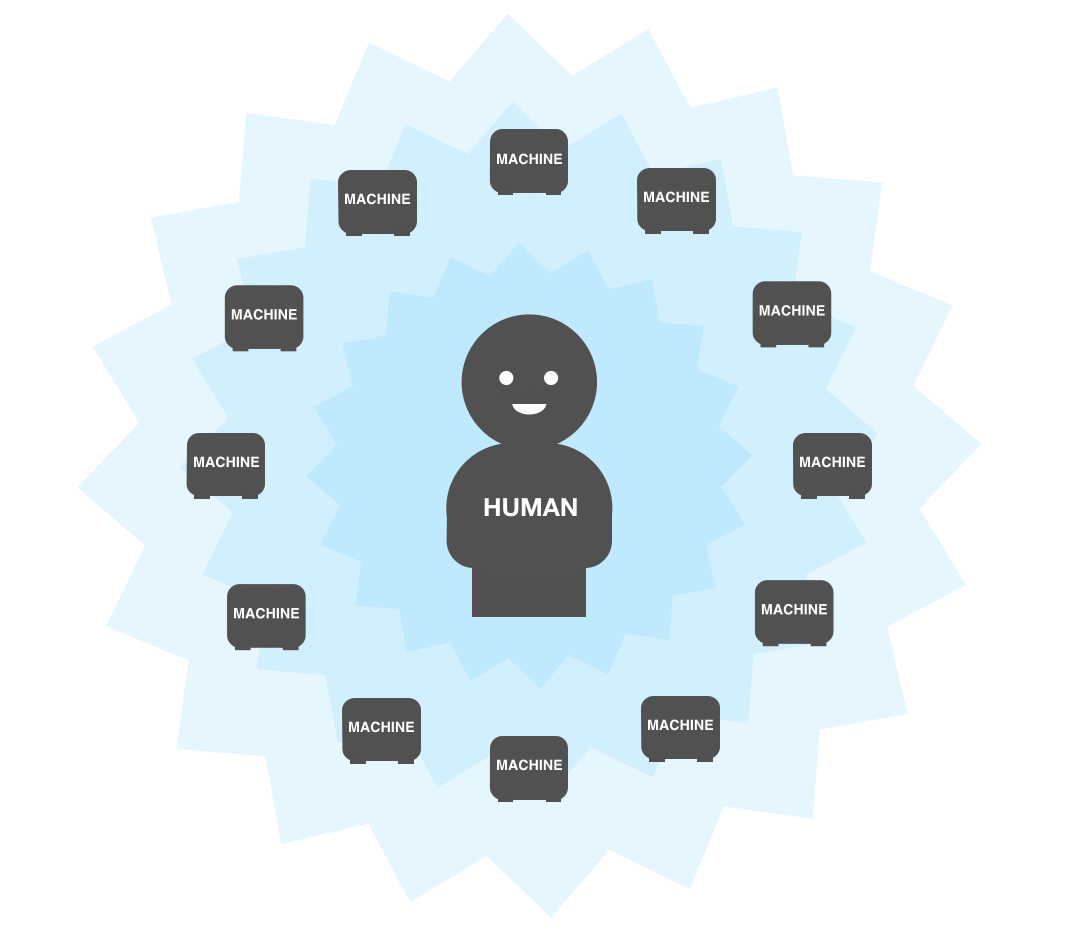
The relationship between humans and machines is continuously evolving. With the rise of the IoT and the Industrial IoT (IIoT), machines are becoming increasingly self-aware and interconnected. Designing for a future where machines are even more deeply integrated into human life, requires us to understand the nature of machines, their role in creating value for humans, and ultimately how machines form an essential part of human evolution with the human in the center of an ecosystem of devices, and tools that we have created around us and that will consequently keep growing.
The Machine
Humans started using machines about 750,000 years ago by creating the so-called stone axe (other figures say 1.6 million years). The stone axe is more of a tool than machine and in essence has been created by humans to become more powerful — to increase our physical strength.

With time, tools became more refined and specialized. We created the hammer and further on the excavator.
To increase our mobility, to be able to move faster through space, humans build roads and put cars on them and moved around in them. Humans were excited about the idea to be able to fly, so planes were invented. Humans desired to be able to talk to their relatives far away so we created the telephone and further down the line more sophisticated communication devices like smartphones were built.

Machines are Extensions of Ourselves
Humans have tasks to carry out everyday. We eat, move around, work, communicate. Some of these tasks we are able to do without the help of machines. But there is a significant number of tasks that we are only able to carry out by using machines. Tasks that machines carry out are human tasks and not machine task.
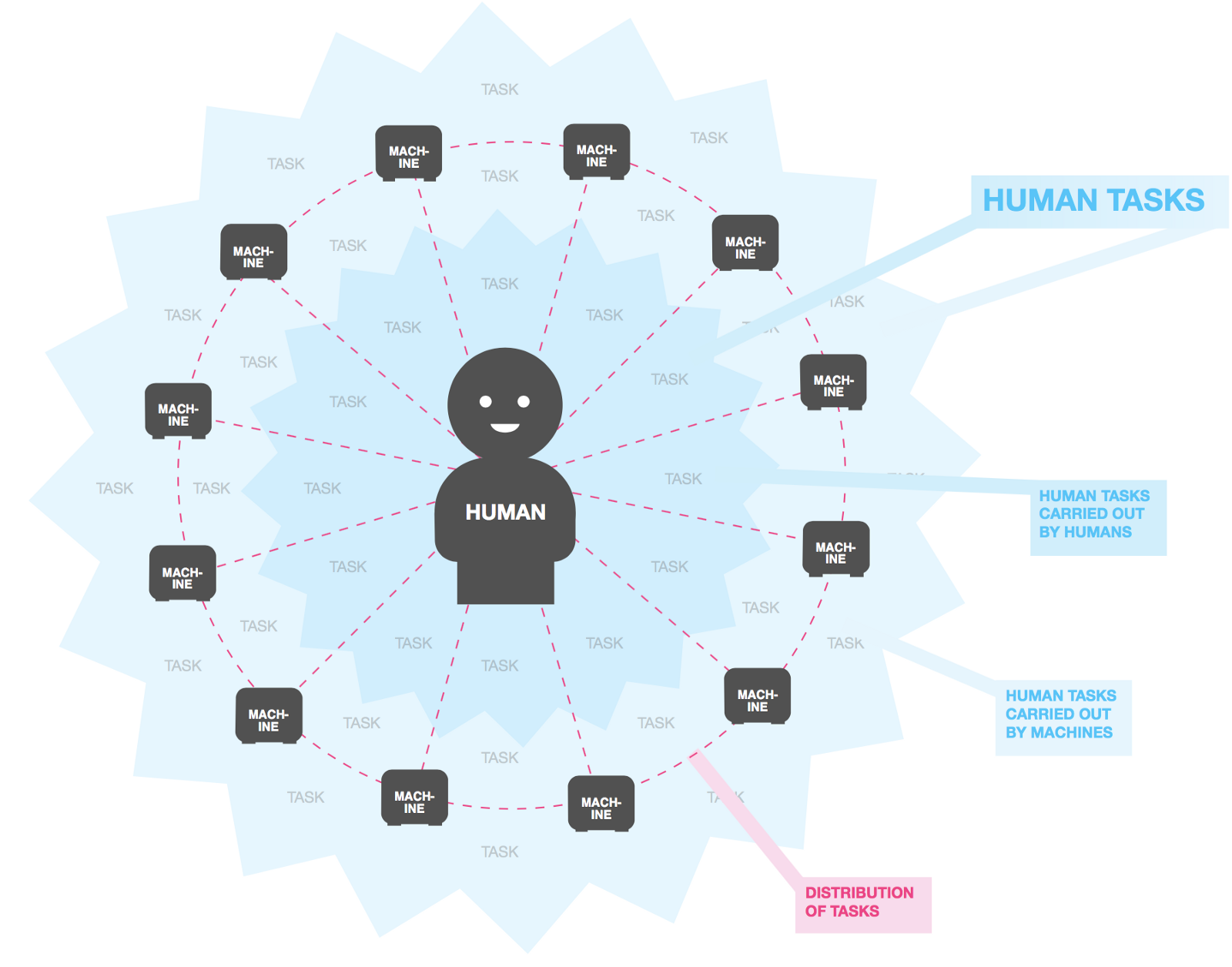
You will find it impossible to find a machine in this world that carries out tasks for its own sake. All are human tasks and machines are extensions of ourselves to carry out our tasks.
The distribution of tasks will happen more autonomously in the future as machines become more self-aware.
This is Evolution
Machines have been part of human evolution since 750,000 years ago with the first use of tools. Through time, human have increased the number of machines we use to extend our sphere of tasks.
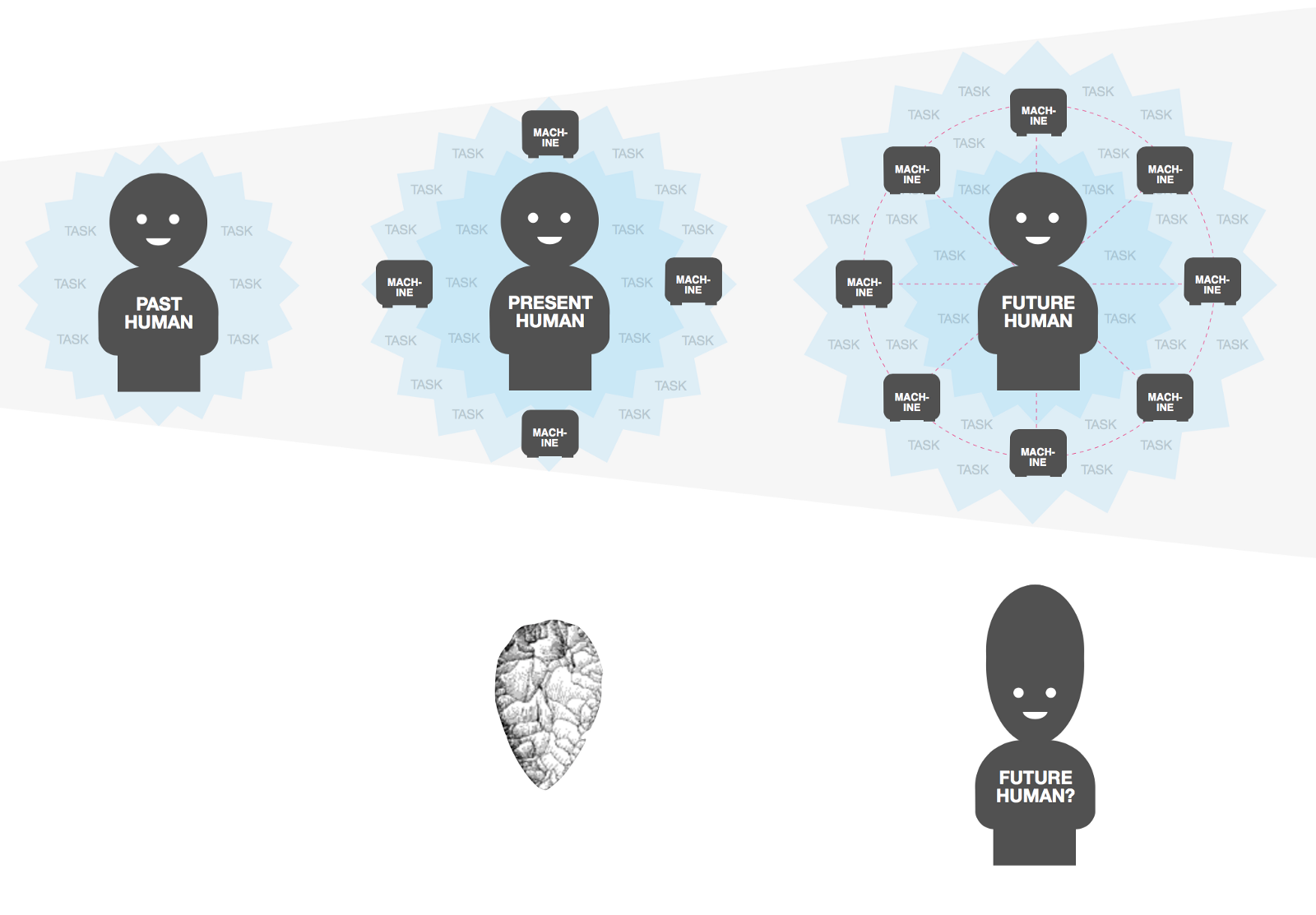
Human evolution cannot be separated from machines. Humans have formed a deep symbiosis with machines. Dependency on machines has increased over time and will increase further until a possible future state of complete symbiosis. Machines are starting to become aware of each other. They are remotely connected to humans as well as they become interconnected.
The Machine is an Organism
The Machine is an organism just as the human is an organism. Looking at a simplified model of the human organism, there is an outer shell which includes all exterior part of the body. Then there are two other major components. First, a processor (the brain) and the a number of sensors distributed across the body. These sensors are eyes, tongue, nose, skin, among many others.
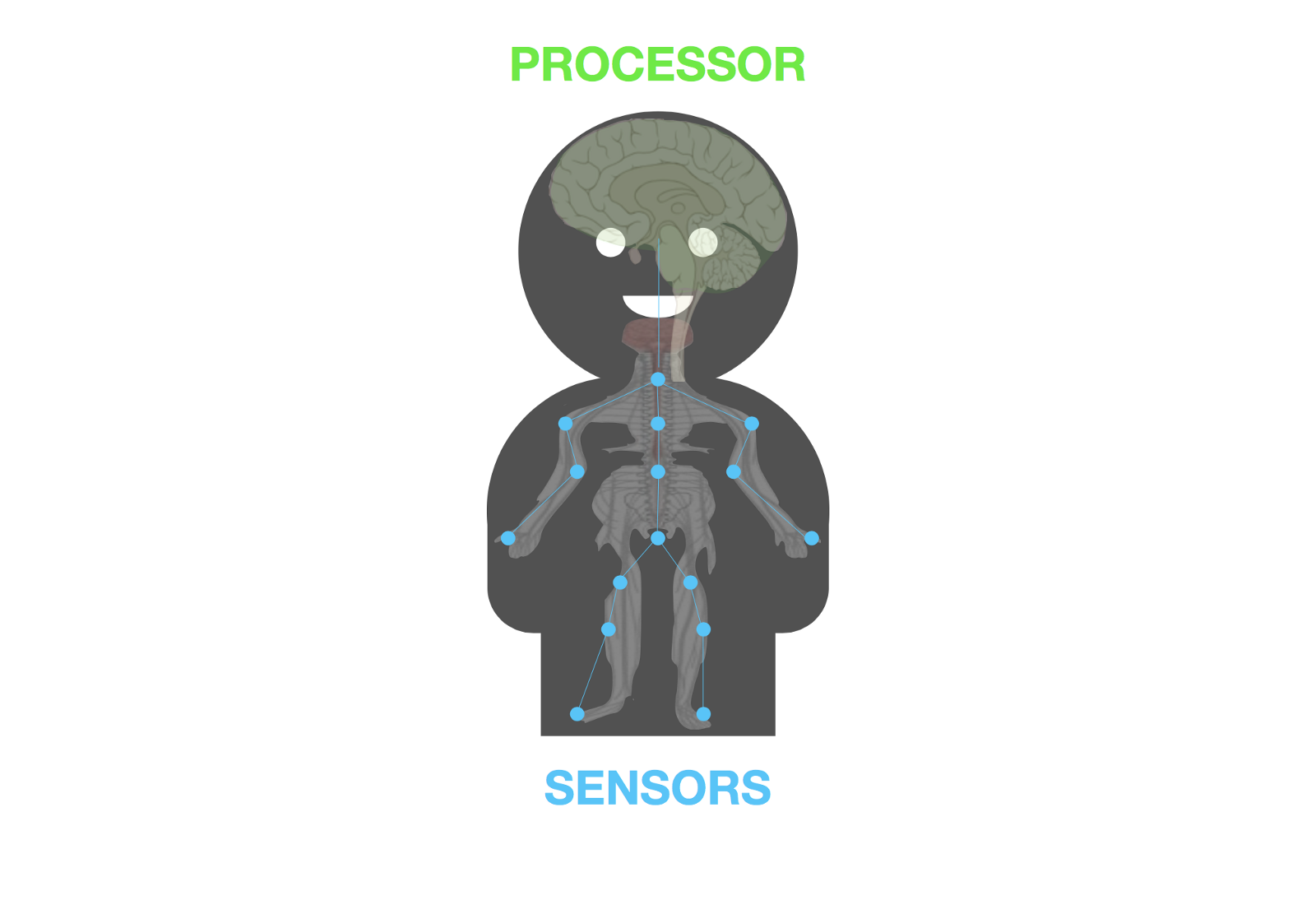
If I apply a flame to a part of my body, sensors will send data to my brain which then interprets the data and alerts me that something is going wrong. Sensors collect data, send it to the brain where the data is processed to then result in meaningful action.
Machines work essentially the same way. There is an outer shell and a processor inside. And there are sensors that measure life-relevant data.
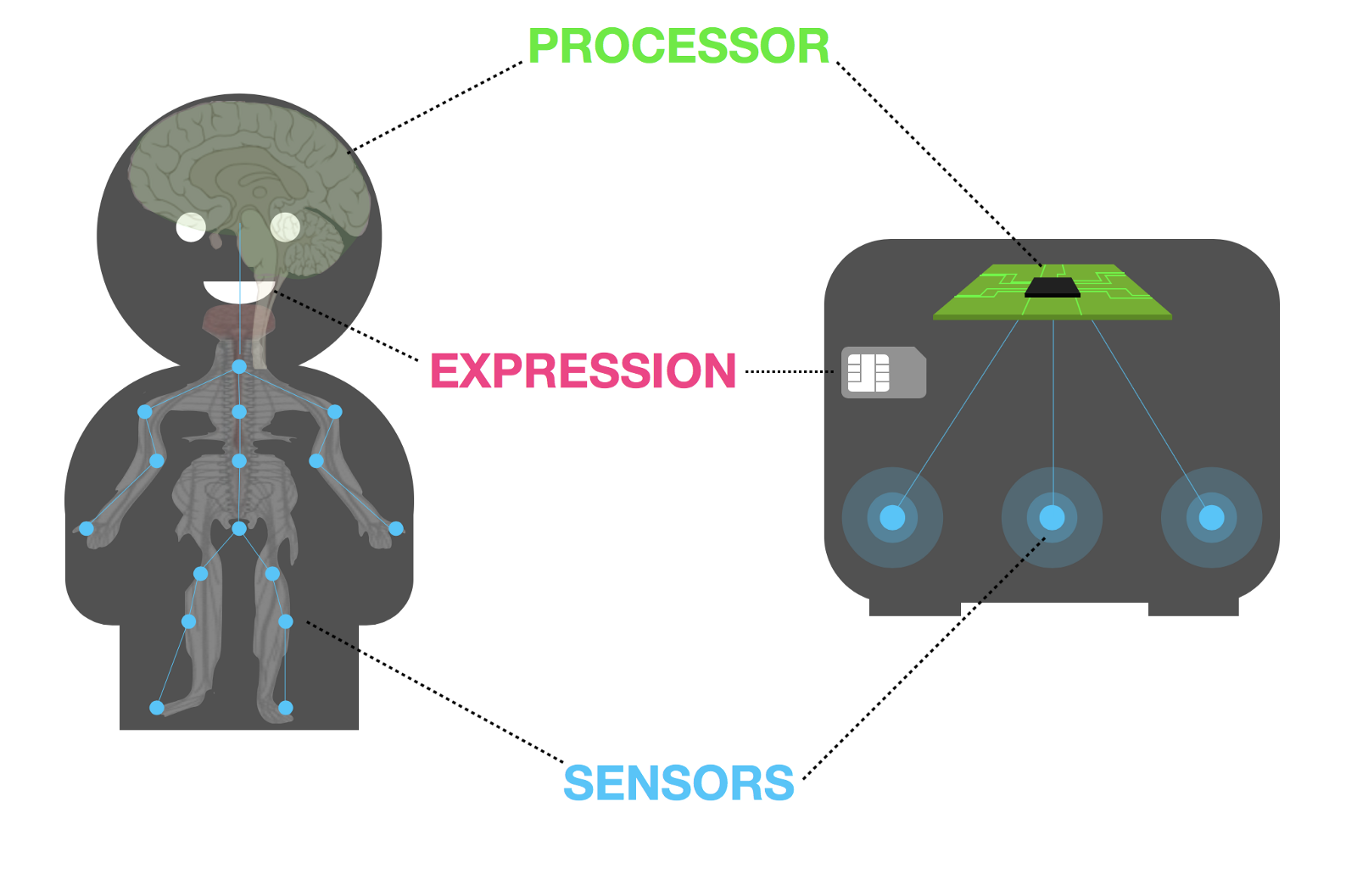
Imagine a machine that needs to maintain a certain temperature in order to function. This machine includes a sensor to measure its temperature. If the temperature rises above a certain level, the sensor would send a signal to the processor. But that alone does not yet solve the problem for the machine.
There is a third relevant layer inside both the human and the machine organism: It is an expression layer which provides the ability to speak. If someone hits me in the face I will say “Ouch!” as a reaction. It is a way to express that something has gone wrong. Machines traditionally include a local feedback layer (either visually or auditive).
Machines that are located in remote places without direct connection to a human, need to contain an expression layer which enables them to communicate their state of well-being remotely.
This expression layer is machine connectivity.
Maintaining Lifecycles / Extending Life
The way human sensors and expression layer work is rather simple. A human is feeling fine and thus happy. If the human is getting sick, the sensors inside the body send information about the sickness to the brain.
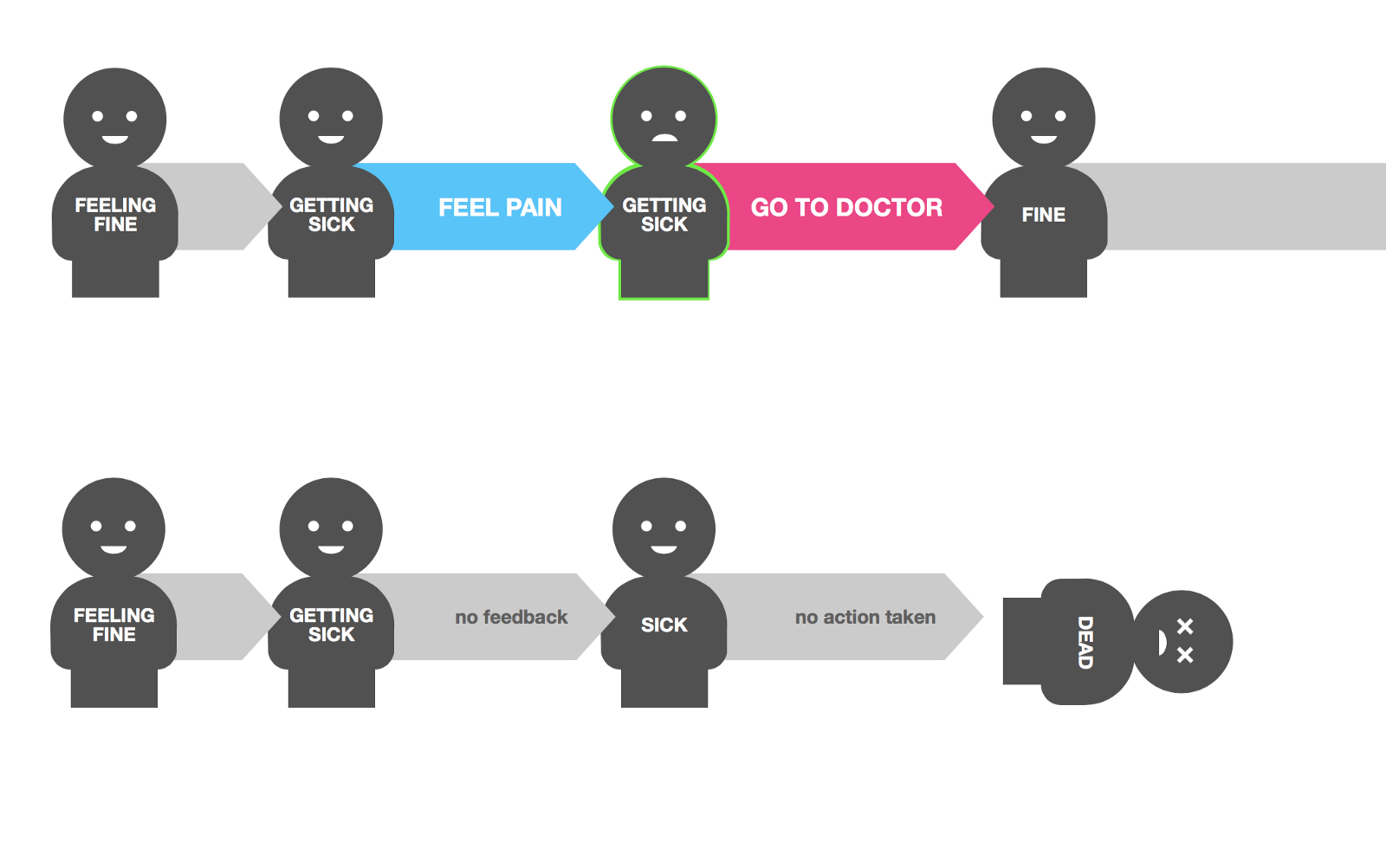
The human then starts feeling pain or some kind of discomfort. Eventually, the human's emotion is being affected. The human feels bad and as a result, the human goes to see a doctor. There, the human tells the doctor “I have a pain in my wrist” and the doctor will cure the pain and its cause if possible and the human will go on living happily.
But what if the sensors or expression layer didn't exist? If we didn't have neither, we would feel fine even though we were getting sick. We would be sick without noticing it. We would die (happily) since no action was taken.
This is essentially what happened to machines until recently. When a key component of the machine broke, the machine was left unaware of and unable to express the damage. The machine had no way of telling the human about it. The machine would eventually break.
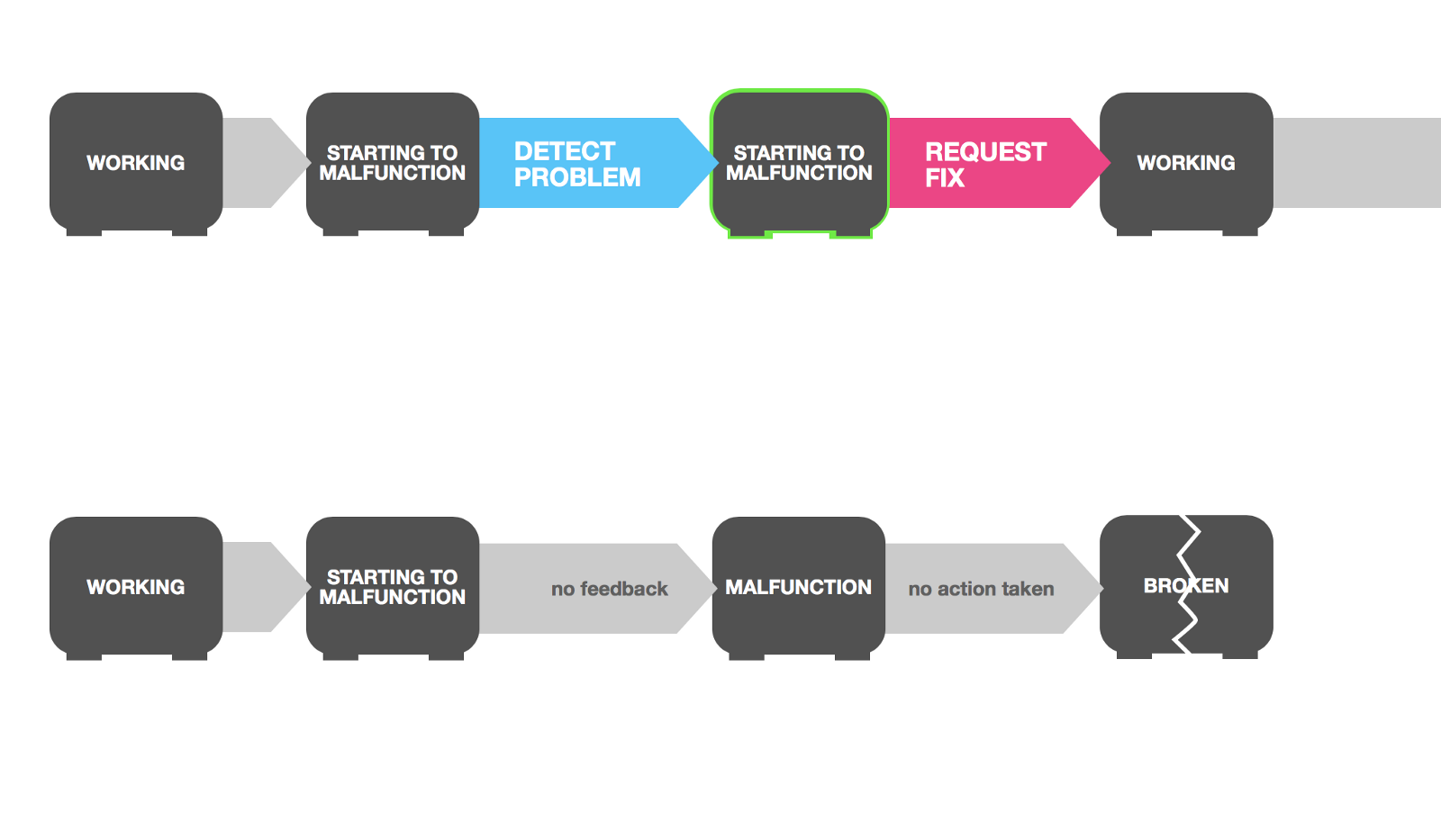
In a world of IoT services, the machine that starts to malfunction is able to detect a problem. There are sensors monitoring its key functions. Once a problem is detected, it can be communicated to the human (either locally or remotely). A fix can be requested and the machine will keep on working for much longer.
The value proposition of the Industrial IoT is maintaining the lifecycle of machines. In human language, it is about extending (machine) life.
Reflecting about how machine tasks are in essence human tasks and how machines are extensions of ourselves, suddenly a notion of life appears somewhere in there. In order to dive deeper into this mental model, I'm going to lay out some thoughts on “purpose”.
From Purpose to Personality
There is purpose for the existence of anything — from the purpose of human life to the purpose of a vacuum cleaner. Purpose typically derives from tasks that something is carrying out. The continuous repetition of carrying out a certain task results in the attribution of a role. Within society, the inheritance of a role over time is accepted as part of someone's personality.
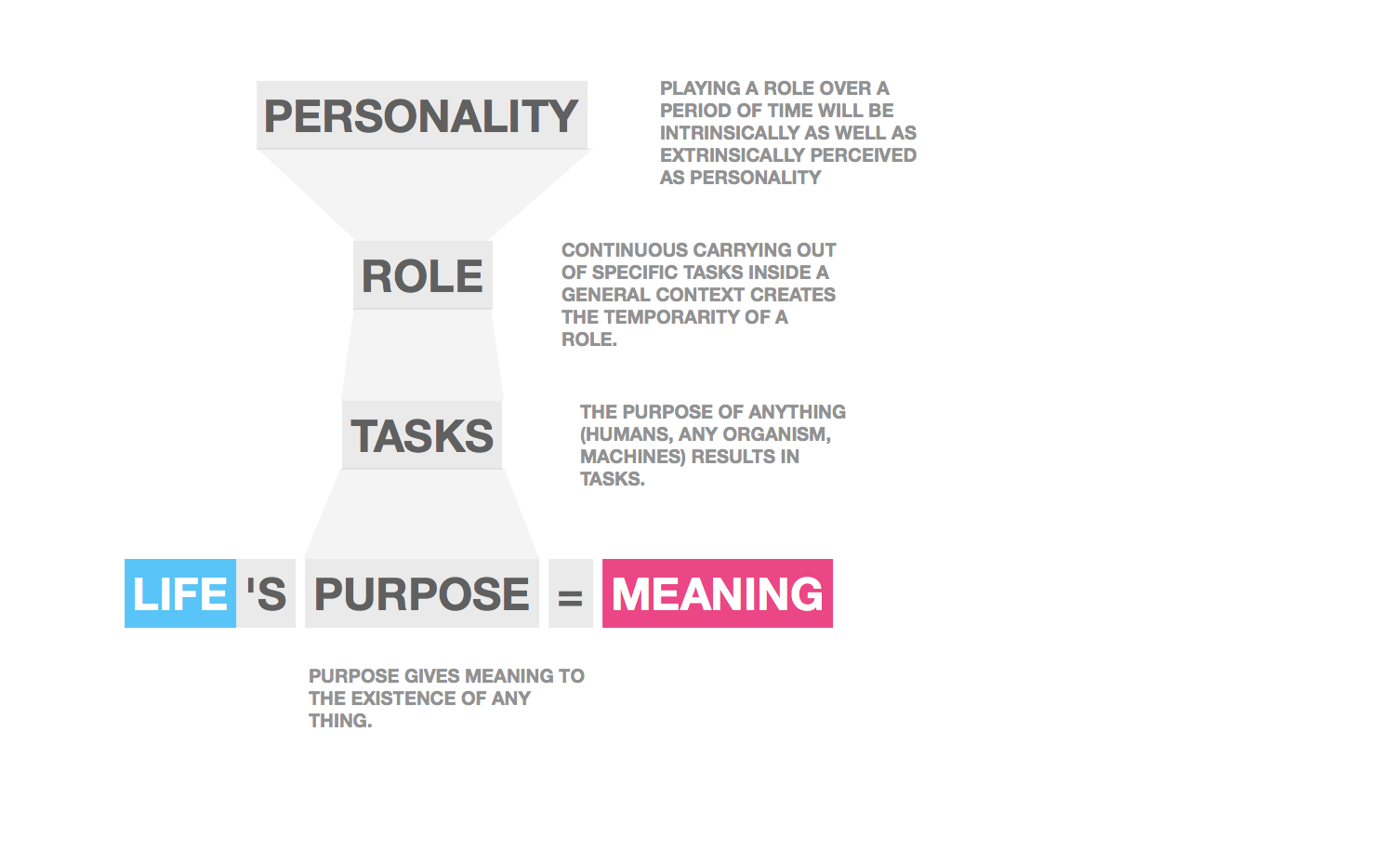
A person who has taken the role of “the funny guy” within a social agglomeration (such as the office) will eventually be perceived as a funny person (aka as someone with a fun personality). People around that person will eventually accept the person in that role and will perceive that as part of that person's personality.
Humans think of personality as something solid and static. The reality is that personality is constructed solely on top of roles. Roles can be quite dynamic and subject to change at any time. Personality in a way is an illusion depending on the continuous inheritance of a role.
The Personality of the Machine
The model of roles and personality can be applied correspondingly to machines. Let's think of a refrigerator: The purpose of the refrigerator is to keep food fresh (its purpose in not to cool — the purpose is to keep food fresh). The reason why the vast majority of us own refrigerators is because we want to keep our food fresh. The purpose of the refrigerator of keeping food fresh derives into the task of maintaining food's temperature at about 6 degrees Celsius. That keeps food fresh which is the purpose of refrigerator. Again, the task is to maintain a low temperature. Tasks derive into activities which in the case of the refrigerator is running a compressor that constricts the refrigerant vapor, raising its pressure to maintain a low temperature inside the refrigerator.

Activities based on tasks can result in needs. The need of a refrigerator is keeping its door closed in order the keep the temperature at a low level. Another need is staying connected to the electrical power to keep its compressor running.
Arising needs of a refrigerator and any machine create a necessity for expression. A refrigerator needs to be able to express something equivalent to “Please close the door” when its door has been left open.
The expression of the need to keep the door closed by a refrigerator based on the purpose to keep food from fresh will be perceived by humans as behavior. And above all, that sort of machine behavior will be perceived as something credible.
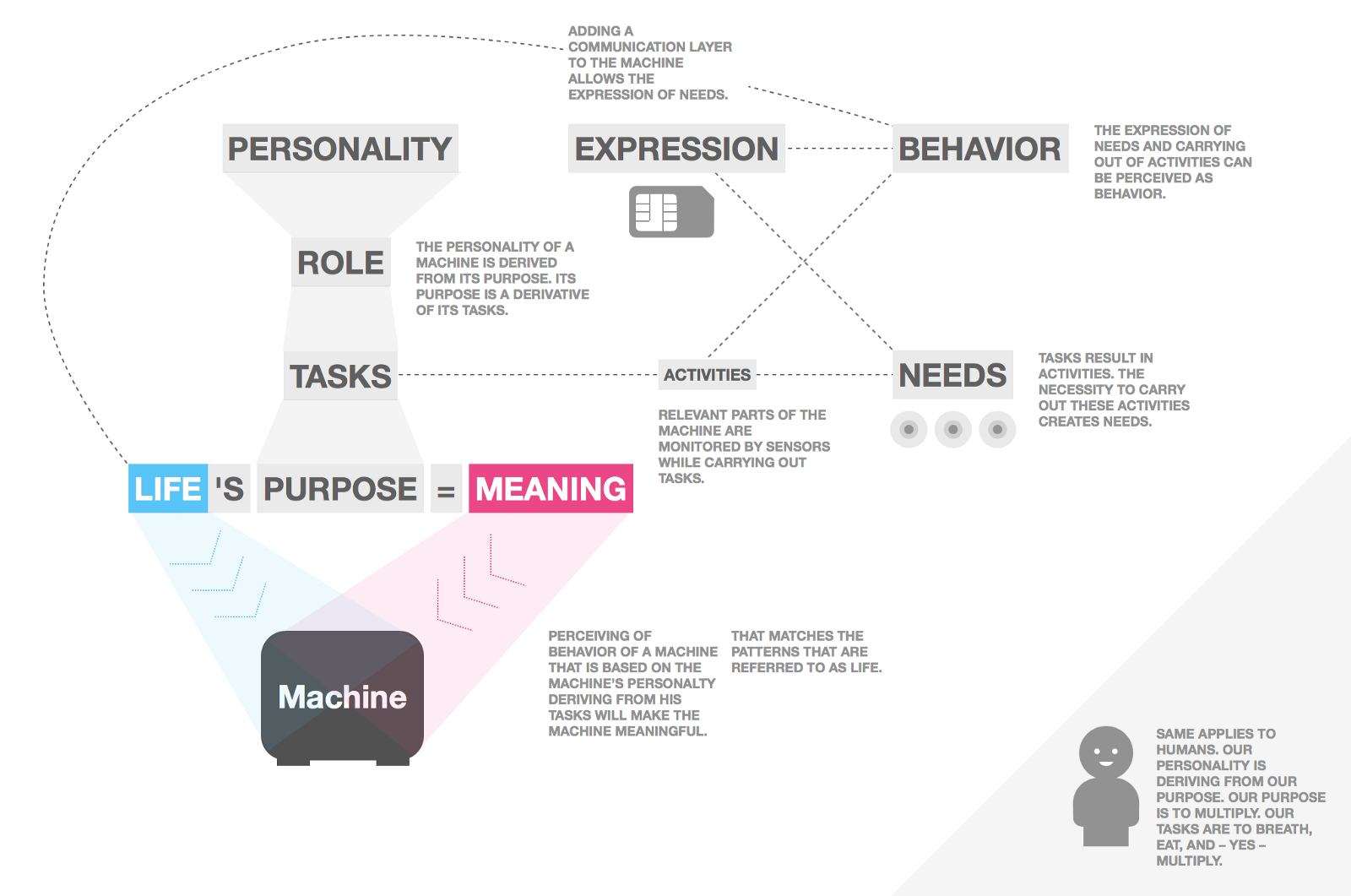
By carrying out human tasks, the machine becomes an extension of ourselves. Not just in the sense that the refrigerator is an extension of human life but essentially life is part of the refrigerator. We as humans perceive the refrigerator — if its expression layer is perfectly designed — as something that is actually living as opposed to something that is acting as if it was alive. It actually is alive because it is carrying out human tasks. It is part of the human life ecosystem.
This model can be applied accordingly to the human. Only the specific purpose and tasks differ.

The purpose of human life is (this can obviously be argued about) maintaining the human species. This purpose derives into tasks which are all about staying alive and surviving: Humans breathe, humans eat, humans procreate. All we do on this level is running around, trying to eat, trying to have sex, and get some sleep. That's what we do.
Breaking these tasks down into activities, these are food gathering aka grocery shopping, being socially active aka socializing, aiming at getting a well-paid and ideally inspiring job, and so on.
And these activities derive into needs. Needs are for example maintaining a healthy nutrition level or aiming for an adequate social standing. Also, we express these needs. Humans say things like “I really like you, I think you're a really nice person” to build inner-human relationships or “I love this company” when they want to get or maintain a certain job.
Obviously, we would refer to this as human behavior and naturally we find this behavior credible to be an expression of something that is life, that is alive, and we find that there is purpose behind all of it.
As a counterexample, let's look at something to which this model does not apply: You might or might not remember the Tamagotchi (たまごっち) from the 1990s. Tamagotchis were little plastic devices with a screen that mimicked life by frequently requiring their owner to push a button in order to receive virtual food.

The model breaks with this kind of machine. The purpose of this device is to create an illusion of life. Thus, the task of this device is to continuously ask for food or some kind of a remedy. But the real need of this device has nothing to do with food. Food is a fake need. The real need of this device is to have a working battery. The entire expression and behavioral level of this device has nothing to do with its needs nor its tasks nor purpose. This is not about life. Life cannot be mimicked.
It is crucial to understand that Living Machines is not about copying or mimicking life and thus creating an illusion of life. It is about machines actually being life because of them carrying out human tasks.
The Scalability of Meaning
Looking onto the previous model with an increased level of abstraction, we can conclude that if machines were designed in a way that expression is coherently tied to their tasks and purpose, we as humans would credibly and naturally perceive machines as life.
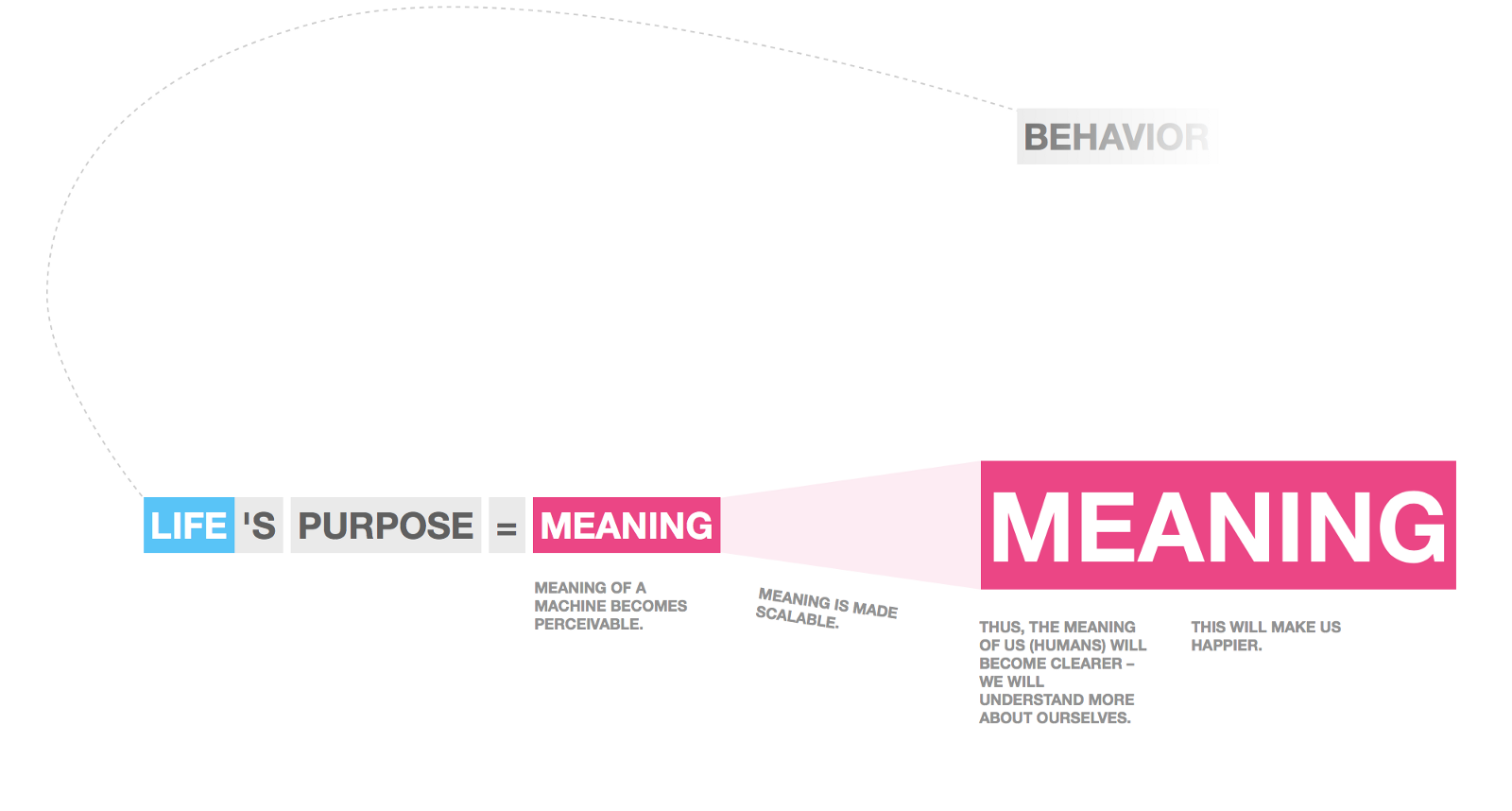
Machine purpose and human purpose is not the same thing but it's hyper-related. The machine purpose is based on the human purpose of surviving and to maintaining its species. Understanding that meaning and purpose of the machine essentially is perceiving our own meaning and purpose. Feeling your own purpose makes you happy. The feeling of the absence of purpose will make you feel unhappy.
If meaning can be made “scalable” which in essence means deriving human purpose from machine purpose through their task relation, humans will feel an increased level of happiness by perceiving their own purpose.
Endangerment of Purpose
Imagine being a vacuum cleaner. Having a conscience of your purpose of keeping the house dust free and your task of absorbing dust into your body, you would have a high interest of being used.

Otherwise there is no purpose. Otherwise you could be destroyed or thrown away or converted into something else. Based on its purpose, a vacuum cleaner has an interests to be used. This also applies to us as humans.
The Quality of Expression
How would a refrigerator indicate to a human that it is in need of closing the refrigerator door? How would a vacuum cleaner with a full dust bag indicate for it to be replaced?
Imagine a scenario where all kitchen appliances talk to you. You would absolutely hate it. You would enter your kitchen after coming home from work and all machines talk to you, telling you to remove this and change that. This is not what we want.

We can break expression down into separate pieces. There are two groups of expression components. There are refiners and there are intensifiers. A machine should exclusively express itself about its needs. First it should indicate what the problem is, then the severity of the problem, and thirdly a possible solution to the problem.
Using the vacuum cleaner as an example: The problem is that its dust bag is full. Expressing the severity means indicating how full the dust bag is which means how long the vacuum cleaner can go on before damage happens. The solution to the problem would be to change the dust bag.
Ideally, all of these three pieces (problem, severity, solution) are be part of the expression. The design challenge is to fit all three pieces into a radically simple, non-verbal expression. We don't want machines to actually talk. Machines don't deserve to talk. They are too trivial to talk.
There are a number of paradigms that can help designing a meaningful yet simple expression layer.
Using existing Expression Channels
Machines do not necessarily need to have an explicit expression channel. They can make use of already existing components as channel. A water faucet or a lamp can temporarily turn itself on and off in order to express needs in an abstract manner to the human.

The Coherency of Expression and Purpose
The expression channel used by the machine should directly reflect the subject of need. In the example of a refrigerator expressing the need to shut its door, the subject of the need is the door itself. The subject of need can be used as expression channel. A need around a door to be closed would ideally be expressed by the door itself.
Machine Helps Machine
Any machine that is conscious of its purpose can offer its service to a human when another machine that fulfills the same purpose fails. This requires machines to be aware of their own purpose as well as of the purpose of the machines in their close physical proximity.
Imagine a scenario where a water fountain doesn't work. A human is trying to get water from the fountain without success. The vending machine next to the water fountain is aware of the fountain's purpose and malfunction and “suggests” its service to the human. As expression channel it chooses to simply drop a bottle of water. The same scenario works vice versa as well.
Super-Organisms
Until now we've exclusively been thinking around single entities of machines: One car, one refrigerator, one vacuum cleaner. Single entities of machines are typical for consumer products. Not so for businesses and their assets. Think of a car rental service like Hertz. Hertz owns hundreds of thousands of cars worldwide. A single entity of a car is irrelevant. The entire “population” of cars is relevant to the business. What matters is maintaining the lifecycle of these assets, keeping them alive and healthy in order to generate revenue and reduce costs.

The perspective for a car rental company is not a single car — it's the entirety of all cars. The entirety of all machines that are part of a business can be called super-organism of machines.
Organization Levels
Looking at different organization levels will allow us to understand super-organisms further. The most commonly recognized and relevant organization level of humans is the human organism itself — one human entity. Prior organization levels are cell level, molecular level, and atomic level which remain rather unrecognized in everyday human life.
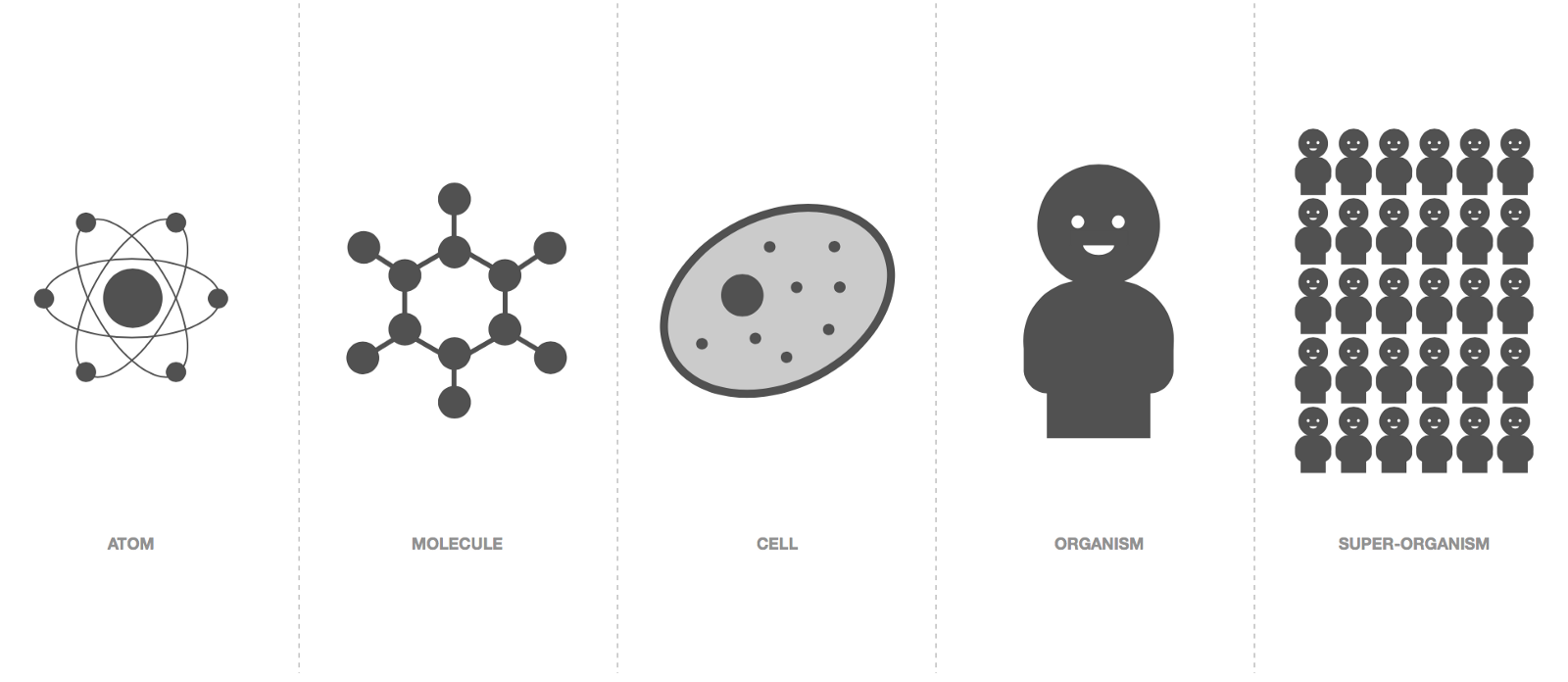
The relevant organization level can vary for different species of things. Let's briefly analyze three species: ants, humans, and machines.
At the organ level, we look at an ant body part, a human organ, and a machine part respectively. The organ level does not seem as relevant in everyday ant, human, and machine life as the organism level. At the organism level we find an entire ant, a entire human, and an entire machine — all as “complete” entities.
One ant might be in a way irrelevant because it alone is not capable of accomplishing relevant workloads (from a human point of view). We perceive a single human entity as more relevant. Super-organisms of ants are well known to us in their visible manifestation as anthills. It is probably fair to say that the super-organism organization level of ants is the most relevant for the ant species.
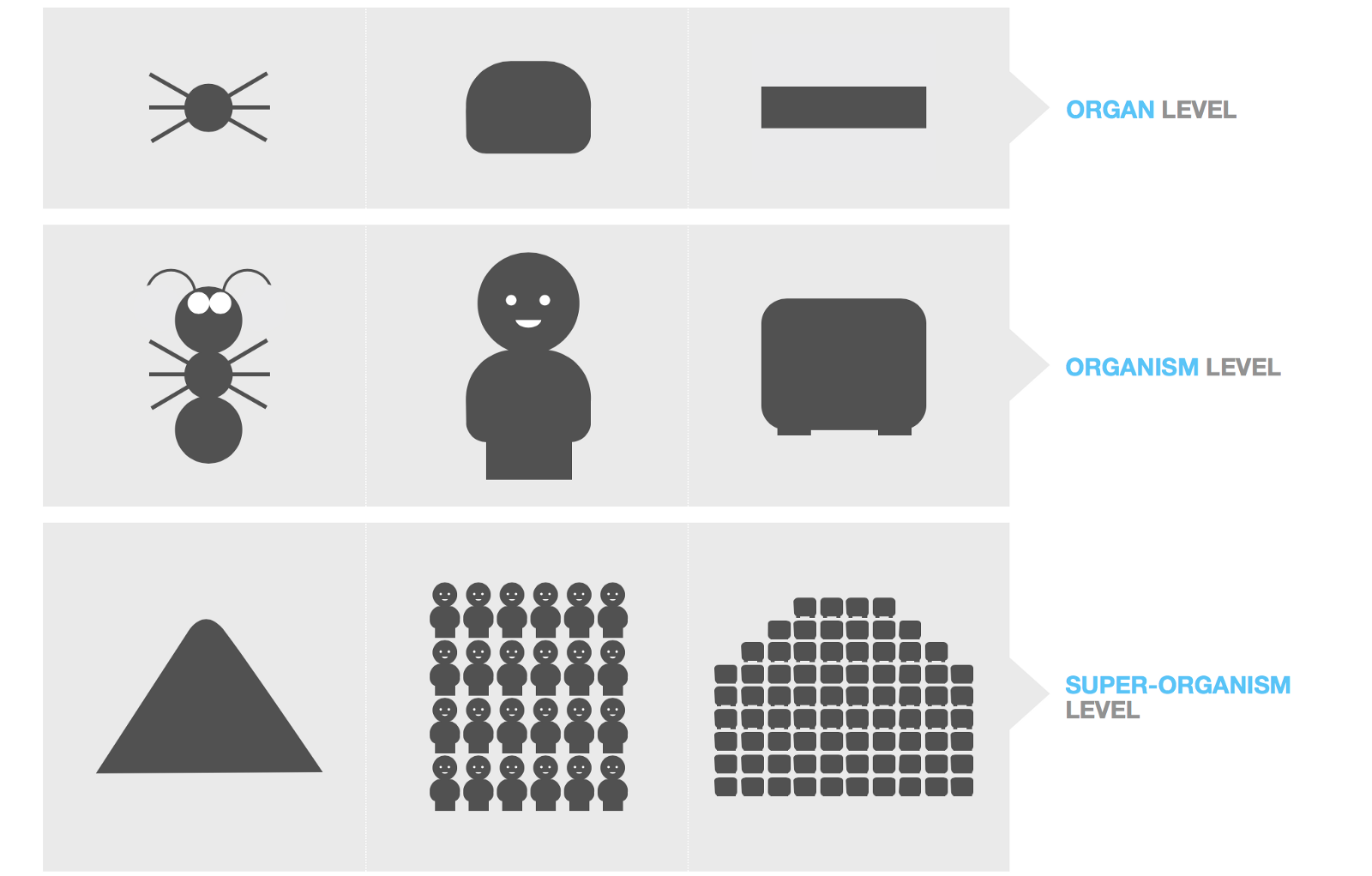
Humans form super-organisms in the form the workforce within one organization such as a business (for example all Apple employees) or the supporters of a sports team. Imagine a large crowd of supporters cheering for their team inside a sports stadium. It feels like a super-organism because it actually is one.
Super-organisms of machines can be all rental cars of a rental company or any business-relevant assets that exists in large quantities within one organization.
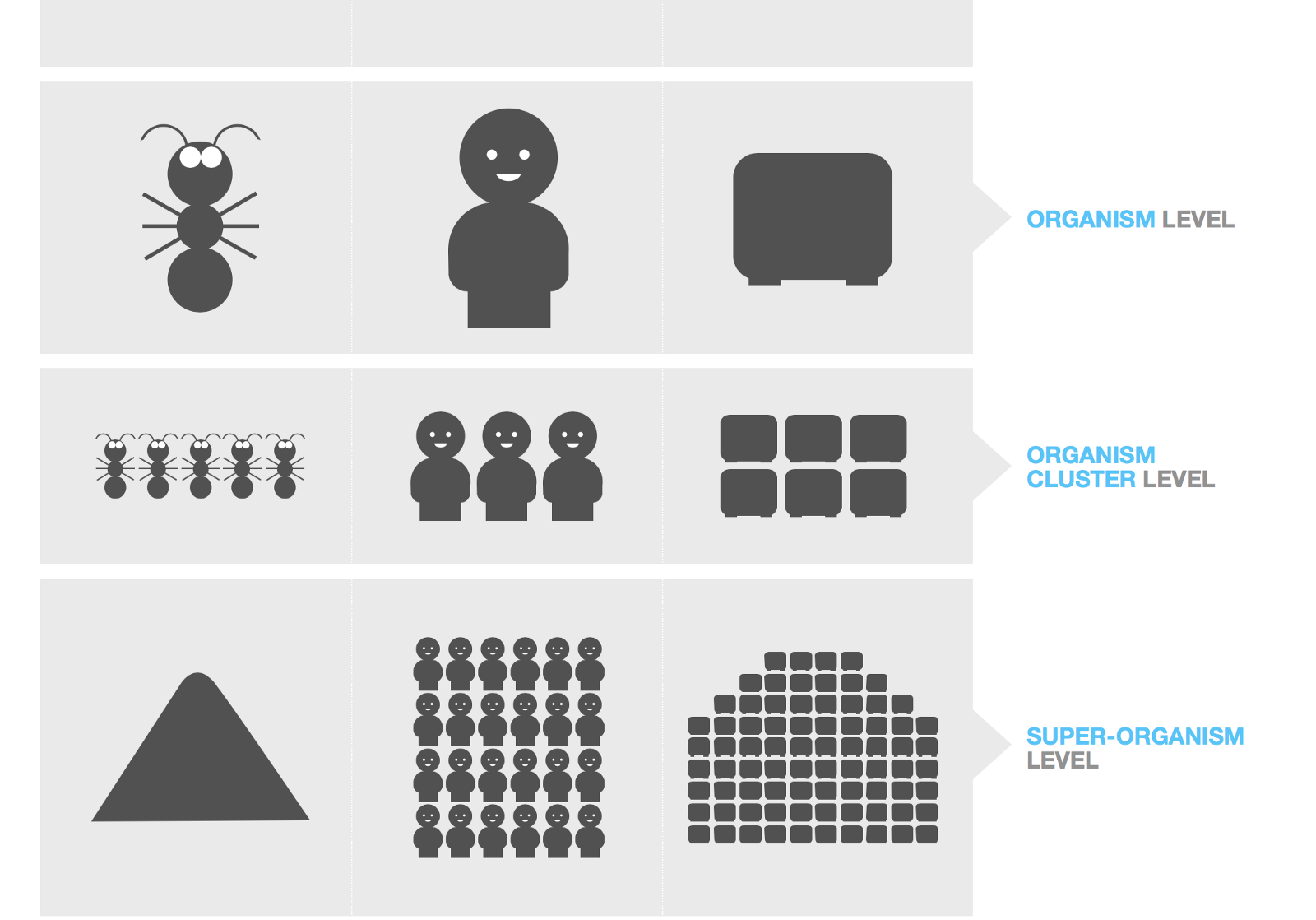
An intermediate organization level between the single organism and the super-organism is the cluster of single entities. In the case of the ants, these might not be relevant. A human organism cluster can be a family which indeed seems relevant as an organizational level. Machine clusters could be all vending machines within one building.
One fascinating example for an existing and very literal super-organism is that of the Siphonophore. It is composed of individual animals called zooids. Every single zooids inside this super-organism has its assigned role while in its entirety it is being perceived by us as one single entity. Watch the video here:
wikipedia.org/wiki/Siphonophorae
The Super-Organisms made of Machines
Let's go back briefly to the paradigm of the machine as an organism: Sensors, processor, and an expression layer are the essential components of the machine organism. Applying this model to a super-organism of machines, every single machine will act as a sensor. If one machine breaks inside the super-organism, it doesn't cause a system-relevant problem. The processor inside the super-organism of machines is a super-processor — an über brain that is able to process all data from within the super-organism.



Super-organisms can be made of any kind of machine type. They can be a super-organism of vending machines, of alarm systems, of cars. In all cases, the assets-owning business is able to control parameters like stock level, temperature, battery level, geolocations, and others. Each single asset is aware of the state of the entire system at any time. The über brain provides business intelligence by allowing the human to understand the system and to create rules for machine behavior.
Conclusion
Machines are extensions of ourselves, they are part of human evolution, they are in essence life. If we embrace that understanding and design for it, wonderful and smart additions to the ecosystem of devices around us will be the result.